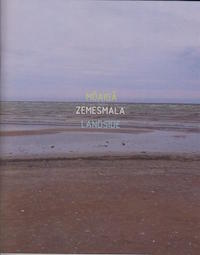Harpist, songwriter, and vocalist Elizabeta Lāce released her first solo album in 2016. Entitled Mōaigā (or Zemesmala in Latvian, or Landside), the album is a collection of experimental instrumental works, performed entirely on the harp. Lāce, who has performed with groups such as Sus Dungo and Dzelzs vilks, has always been a major creative force in Latvian music, and this album has her branching out in yet another direction.
The album title – Mōaigā – is from the Liv language, and Lāce intended the album to be a celebration of the Liv culture, especially considering that there are very few Liv left. Lāce herself has been studying Liv culture and history, and these studies provided the inspiration for this album.
The atmospheric nature of the album becomes clear with the opening sounds of the song ‘Smiltis’, with the sound of the rustling wind then giving way to a slow procession of notes, evoking a late night or early morning stroll on a beach devoid of any other people. The song ends as quietly as it begins, and seems to almost drift away into the sea.
The song ‘Vētra’ (or Storm) is actually not as tempestuous as the title might indicate, though the deliberate progression of notes on the harp, gradually building to a crescendo, indicates a perhaps more emotional storm, which then slowly tapers off and recedes.
The serene and sacred atmosphere of a walk through a cemetery is presented in ‘Kapsēta’, perhaps the quietest work on this album of hushed songs. Elements of the Latvian folksong ‘Ej, saulīte, drīz pie dieva’ can be heard, and Lāce intertwines the melody with her own vision of a somber search for a particular headstone.
The most ominous work is ‘Ugunskoks’, which is dedicated to the Jews that died at the Salaspils concentration camp during World War II. Its low rumblings, indicating a sense of dread and fear, gradually build in emotional tension, making for unnerving and disturbing listening.
Though the album is purely instrumental (managing to get not just music, but all kinds of sounds from a harp), the booklet with the CD does include some poetry and stories (in Liv, Latvian and English), perhaps as a guide for better understanding of the musical works. Oddly, the booklet makes no mention of those that worked on the album (such as sound engineer Gundars Rullis or Alis P – with whom Lāce played on his album Ciparu pasaule). The album booklet also contains photographs taken by Lāce in locations where Livs live.
The improvisational and ambient style gives the album an overall dreamy feel, though one does wish at times that there had been a few more active, energetic sections to balance the calm and serene ones, though it is clearly intentional that the album moves at such a slow pace, perhaps as a balance against the frenetic modern world.
Elizabeta Lāce, at once creative and slightly eccentric (she once staged a performance while sitting in a rowboat full of water and slowly submerging herself) has made an album that showcases her creativity, but may be difficult to understand for some listeners. Some may hear a captivating sonic journey through nature, while others may just hear someone absentmindedly plucking at a harp for almost an hour. As it is indeed experimental harp music, absent of clear melodies, it does require a bit of imagination to enjoy and appreciate. The songs do tend to blend into one another, which is perhaps the idea, as it is meant to evoke a stroll by the sea, through the woods, and other depictions of natural phenomena. Elizabeta Lāce, on her album Mōaigā, utilizes her extensive musical and creative talents to present many unexpected and unusual aspects of the harp in her unique vision of nature.
Elizabeta Lāce
Mōaigā
2016
Track listing:
- Smiltis
- Vētra
- Dieva suņu ēnas
- Vējš
- Nakts
- Cilvēki
- Langa
- Diena
- Ugunskoks
- Kapsēta
- Saulriets
- Laiks
© 1995-2024 Latvians Online
Please contact us for editorial queries, or for permission to republish material. Disclaimer: The content of Web sites to which Latvians Online provides links does not necessarily reflect the opinion of Latvians Online, its staff or its sponsors.





